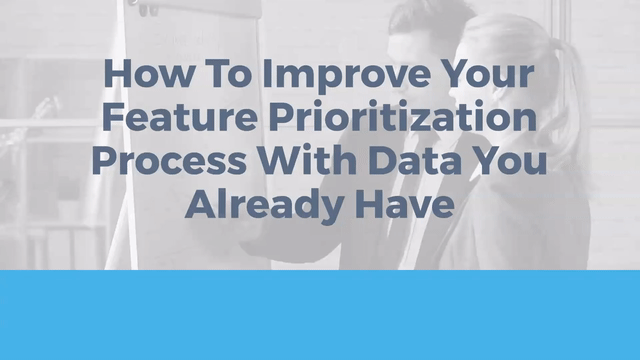Not having a clear feature prioritization process can be maddening. Your team is ready to go, pressure is mounting, but you don’t want to spend energy pushing in the wrong direction.
Don’t worry—there’s a secret weapon hiding in your product: data.
In a few easy moves, you can use the data you already have to map out a crystal-clear feature prioritization plan. In this article, we walk you through how to use data within your product to prioritize features, inform product enhancements, and drive decisions your users will love.
What is product and feature prioritization?
Product and feature prioritization is the process of choosing what features and product enhancements to include within your product strategy. As a product leader or manager, you aren’t just in charge of improving your product. You also have to chart a course that satisfies users, stakeholders, teammates, and the entire company.
Your product roadmap will be the glue that holds it all together. By creating an effective product roadmap, you’ll have the blueprints to build out a better customer and user experience. And by nailing down your priorities early on, you can reduce your team’s workload and uncover meaningful product outcomes.
How do you prioritize features on your product roadmap?
Prioritizing features may seem like a massive task. Product leaders and managers are constantly slammed with opinions from all angles. However, if you want to focus your efforts and prioritize features, anchor your product roadmap in data.
In-product data, including behavioral data and customer feedback, will provide the raw materials to chisel out a strategy that’s in line with both customer and company needs. Here’s how to get started:
Write out your wish list.
As you gather data from in-product analytics, behaviors, user paths, and customer feedback surveys, lay out a list of opportunities that are possible. Your final list can include everything from product enhancements and possible new features to bug fixes.
Power priorities with a framework.
With data pouring in, you’ll need a framework to guide your feature prioritization efforts. One simple way to prioritize decisions is to use a cost vs. value model. In the cost vs. value approach, you determine each move’s value, note each decision’s cost, and compare how action items intersect. Under this framework, you’ll want to prioritize high-value, low-cost features first and gradually move toward high-cost, high-value items.
How do you use data to back feature prioritization?
Once you have a plan in place, it’s time to scrape through your product and dig up those nuggets of information that will back feature prioritization. Not sure where to start? Here are some surefire places to focus your energy:
- Sticky Features: There are golden features sitting in your product just waiting to be uncovered. By examining customer surveys and user paths, you’ll start seeing features that are drawing extra attention. These sticky features can be high-value areas to jump into enhancements.
- Friction Points: Any time you can cut out friction points within your product, it will improve your user’s experience. In-product breakdowns, such as path analysis and funnel analysis, highlight those spots where users are tripping up. These high friction points are often excellent places to focus your efforts.
- Retention Signals: Retention is critical to the long-term success of most, if not all, SaaS companies. In fact, one CallMiner study found avoidable customer churn is a $136 billion a year problem for companies. That’s why it’s worthwhile to examine figures that indicate churn risk, such as login frequency and the time users spend engaged with features, and plow ahead from there.

What are some tips for better feature prioritization?
With data lighting your way and a framework propelling your feature priorities, you should have the tools to craft a stellar product roadmap. Here are a few bonus tips to help make sure you’re nailing down rock-solid feature priorities:
Pave your own path.
When you’re determining feature prioritization, it can be tempting to mimic the priorities of competitors or other SaaS companies. Try to avoid this trap. Your company, product, and user experience are unique. That’s why it’s better to start with a blank slate and use your company strengths, user needs, and customer experiences to guide your efforts.
Understand your company’s needs.
User insights will be a valuable piece of your product roadmap, but they won’t solve the whole puzzle. It’s also important to consider your company’s needs, goals, and growth stage as you set feature priorities. For instance, if your company is in the startup stage, you likely will need to focus much more on features that drive acquisition than if you’re operating in the maturity stage. The trick is hitting the sweet spot between your company’s goals, resources, and user insights.
Create customer feedback loops.
You can start prioritizing features and product enhancements with the data you already have, but there’s also a way to boost the quality and quantity of feedback: feedback loops. Feedback loops are built-in processes that gather feedback, use feedback to enhance the product, and open the doors to even more user insights. The more you build out this cycle of data, the easier it will be to shine light on the most valuable opportunities hiding in your product.
Learn how to Create a Product Roadmap that Enhances Users’ Experiences and Propels Growth
Now that you have an understanding of feature prioritization and how to incorporate it into your product roadmap, take a deeper dive into what it takes to create a successful customer-centric product roadmap that is fueled by data. Download our Customer-Centric Product Roadmap Infographic today.

